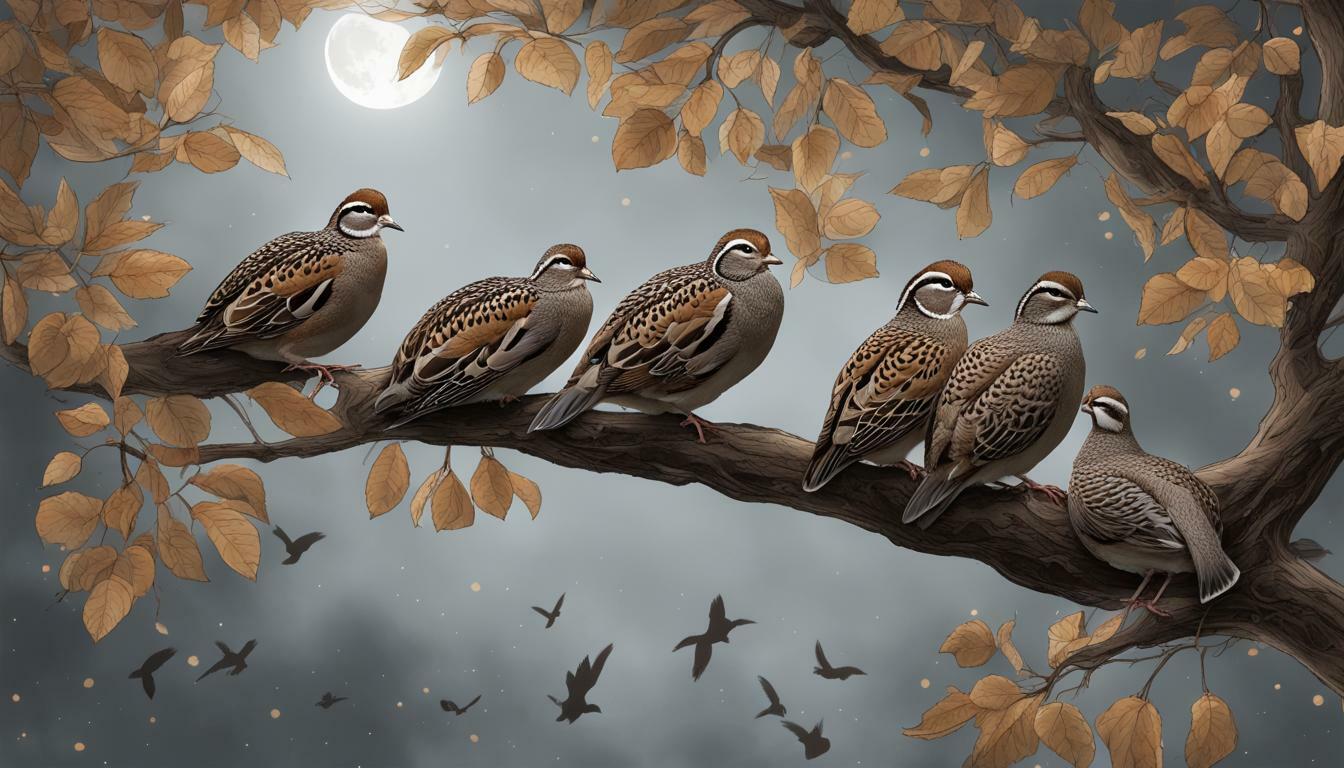Where Do Quails Sleep At Night? Nature’s Mystery Uncovered

Table of content:
Quails are fascinating little birds that have some unique sleeping habits and behaviors. In this article, we’ll explore where quails like to sleep and rest overnight, both in the wild and in captivity.
Where Do Wild Quails Sleep?
Where do quails sleep? In their natural habitat, quails are ground-nesting birds that do not migrate. At night, they have several options for where to settle down to sleep.
On the Ground
One of the most common places for wild quails to sleep is right on the ground. They will find a spot with good cover from predators and vegetation to nestle into. Quails will sleep on the bare ground, in fields, under bushes, near logs or rocks, and in dense grass.
Sleeping on the ground helps quails blend into their surroundings and avoid detection. Their cryptic coloration with browns, grays, and black helps them stay camouflaged as they rest. Ground sleeping sites are also easy for quails to quickly escape from if startled.
In Nests
Do quails sleep in nests? Yes, mother quails and their chicks will sleep together in ground nests. The nests provide insulation and protection for the young birds.
Quail nests are shallow depressions lined with vegetation like grasses, leaves, and feathers. The nests are built on the ground hidden among low cover. Quail nest site selection offers concealment from predators.
Once the chicks are a few weeks old and can regulate their own body temperature, the mother will stop brooding them overnight in the nest. She will then rejoin the covey’s ground sleeping site.
In Trees
While less common than ground sleeping, quails will sometimes roost in trees or bushes at night. This is called tree roosting. They will fly up to perch on a branch rather than sleeping on the ground.
Quails prefer relatively low roosts in dense vegetation for tree sleeping. Their legs and feet are not adapted for gripping narrow branches. Quail perching abilities are limited compared to songbirds.
Tree roosting occurs more often when the weather is extremely cold. Getting off the frozen ground helps quails conserve body heat overnight. It also provides further elevation from terrestrial predators.
Do Quails Sleep In Coveys?
Do quails sleep in coveys? A covey is a social group of quails that live and move together. Covey sleeping is the most common arrangement for quails at night.
Quail covey roosting offers a few key benefits:
- Safety in numbers – More birds means more eyes watching for danger. Being in a group provides increased protection.
- Shared body heat – Huddling close together helps quails retain warmth on cold nights.
- Social bonds – Sleeping in a covey maintains the group bond between the birds.
Covey sleeping sites are circles of bare ground called quail roosts. These areas become indented from the birds settling down in the same spots night after night. The roosts average 10-12 inches across per bird.
Quail communal nests are also used by coveys during the breeding season. Multiple female quails will lay eggs together in a shared nesting cavity on the ground.
Do Quails Ever Sleep Alone?
Do quails sleep solitary? While covey sleeping is most common, quails will sometimes sleep alone. Quail solitary roosting tends to happen for a few reasons:
- Young quails dispersing from their parents’ covey
- Individual quails separated from their covey
- Mother quails incubating eggs in a nest
- Dominant male quails guarding territory
- Quails sleeping in trees apart from the covey on the ground
Solitary sleeping comes with greater risk compared to the safety of a covey. Lone quails must be extra vigilant at night. Their cryptic plumage and staying perfectly still become even more critical.
What Are Quail Sleeping Habits?
Let’s explore how quails sleep and their overnight routines:
Bedding Down
Quails will begin settling in for the night approximately 1-2 hours before sunset. This gives them ample time to find a suitable sleeping site and get comfortable before full darkness.
They will take dust baths around the roosting area to clean their feathers before bed. Then each quail will pick its preferred spot and slowly crouch down into the resting posture.
Quail sleeping postures involve tucking the head against the back, fluffing out feathers, and relaxing the body. Often one leg will be drawn up into the feathers.
Sleeping Period
Once bedded down, quails fall asleep quickly. They have rapid entry into REM sleep given their high-risk environment. Birds can cycle between REM and lighter non-REM sleep several times throughout the night.
Being such light sleepers, they are easily startled awake by noises that could signal danger. Quails must balance getting sufficient rest with staying alert.
Quail sleep cycles follow their crepuscular rhythms. They are most active at dawn and dusk, and get the majority of sleep overnight. However, they do sometimes nap lightly during the day.
Predawn Hours
Quail predawn behaviors include waking up approximately 1 hour before sunrise. They will begin foraging, preening, dust bathing, and socializing with their covey.
This active period lets them get a jump start on the day before temperatures rise. Their early rising also reduces risks from nocturnal predators returning to rest.
Quail Sleep Facts:
- Quails enter REM sleep almost immediately upon falling asleep
- Their sleeping metabolic rate drops around 30% from resting wakeful rate
- EEG readings show quail sleep consists of short, light REM periods
- Quails sleep on average 8-10 hours per day
- They rarely sleep deeply and are easily woken
- Quails sleep with one eye partially open to watch for threats
- Part of their brain stays awake to monitor sounds while sleeping
- They sleep the longest in late winter and take more naps in summer
Where Do Domestic Quails Sleep?
For quails in captivity like those raised for eggs or meat, where they sleep depends on the housing setup:
Brooder
Newly hatched chicks sleep gathered under the heat lamp in a brooder for warmth. Wood shavings line the floor to absorb waste.
Cage or Coop
Adult quails sleep on the floor of their cage or chicken coop. This is often lined with straw, sand, or wood shavings for comfort and cleanliness. They will huddle together for warmth and protection.
Perches are sometimes provided, but quail perching abilities are limited. They prefer sleeping on the ground.
Outdoor Enclosure
In a spacious outdoor enclosure, domestic quails will find natural areas protected by vegetation to sleep in at night, much like wild quails. This mimics their natural sleeping habitat.
Providing brush piles, long grass, and places to take dust baths allows them to settle in comfortably.
Final Thoughts
Quails have adapted some excellent strategies for getting safe, quality rest overnight. Their ground nesting behavior, camouflage plumage, Cryptic coloration, and tendency to sleep in coveys all help protect them. Observing where quails settle down to sleep gives insights into their natural behaviors and requirements. Their unique sleeping habits reflect lives finely tuned to their habitats and predators. Watching quails bedding down can be a soothing nighttime wildlife viewing experience.
Welcome. I’m Adreena Shanum, the proud owner of this website, and I am incredibly passionate about animals, especially poultry. I founded adreenapets.com as a labor of love, stemming from my desire to share my knowledge and experiences with poultry enthusiasts worldwide.




